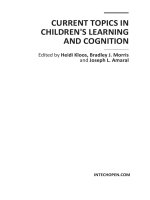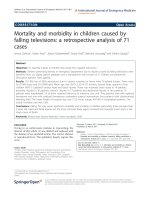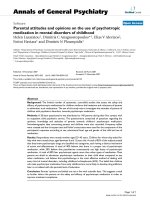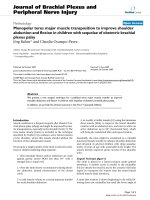STUDENT MOTIVATION, PARENTAL ATTITUDES AND INVOLVEMENT IN CHILDREN’S ENGLISH LEARNING AT DUONG QUANG HAM SENIOR HIGH SCHOOL
Bạn đang xem bản rút gọn của tài liệu. Xem và tải ngay bản đầy đủ của tài liệu tại đây (912.1 KB, 100 trang )
HuNG YeN department of education and training
duong quang ham senior high school
******************
Initiative and experience
STUDENT MOTIVATION, PARENTAL ATTITUDES AND
INVOLVEMENT IN CHILDREN’S ENGLISH LEARNING AT
DUONG QUANG HAM SENIOR HIGH SCHOOL
Teacher
: Ha Thi
Th¬m
Subject
English
i
:
Academic year
: 2012-2013
ii
STATEMENT OF AUTHORSHIP
I certify that the study entitled “Students’ motivation
and
Parental
Attitudes
and
Involvement
in
Children’s
English Learning at Duong Quang Ham Senior High School” is
the result of my work.
Signed:
Dated:
iii
iv
TABLE OF CONTENTS
STATEMENT OF AUTHORSHIP ............................................... I
TABLE OF CONTENTS .................................................... II
LIST OF TABLES ...................................................... .IV
LIST OF ABBREVIATIONS ........................................... ......V
CHAPTER 1: REASON FOR CHOOSING THE TOPIC .............................. 1
1.1 REASONS FOR CHOOSING THE TOPIC ................................... 1
1.2 AIMS OF THE STUDY................................................... 4
1.3 SCOPE AND SIGNIFICANCE OF THE
STUDY.....................................................................
..........................3
CHAPTER 2: LITERATURE REVIEW .......................................... 6
2.1
2.1.1
2.1.2
2.1.3
2.1.4
2.2
2.3
2.3.1
2.3.2
2.4
MOTIVATION IN L2 LEARNING ............................................ 6
Definition ...................................................... 6
Types of Motivation ............................................. 7
Role of motivation in L2 learning .............................. 10
Studies into integrative and instrumental motivations ......... 12
PARENTS AS A FACTOR AFFECTING STUDENTS’ MOTIVATION IN LANGUAGE LEARNING ...... 15
STUDIES INTO PARENTAL ATTITUDES AND INVOLVEMENT IN CHILDREN’S LANGUAGE LEARNING20
Parental attitudes in children’s language learning ............ 20
Parental involvement in children’s language learning .......... 24
SUMMARY .......................................................... 28
CHAPTER 3: METHODOLOGY ............................................... 30
3.1 DATA COLLECTION INSTRUMENTS ......................................... 30
3.1.1 Questionnaires ................................................. 30
3.2 SUBJECTS ......................................................... 34
3.2.1 Student population ............................................. 34
3.2.2 Parents ........................................................ 35
3. 3 PROCEDURES ....................................................... 36
3.4 DATA ANALYSIS ..................................................... 37
CHAPTER 4: RESULTS AND DISCUSSIONS ................................... 39
4.1 STUDENTS’ MOTIVATION IN ENGLISH LEARNING ............................... 40
4.1.1 Integrative motivation in English learning ..................... 40
4.1.2 Instrumental motivation in English learning .................... 44
4.1.3 Parental attitudes and involvement as perceived by students .... 47
4.2 PARENTAL ATTITUDES AND INVOLVEMENT IN CHILDREN’S ENGLISH LEARNING JUDGED BY PARENTS
................................................................... 52
4.3 PARENTAL ATTITUDES AND INVOLVEMENT IN CHILDREN’S ENGLISH LEARNING PERCEIVED BY
STUDENTS AND PARENTS .................................................. 56
4.4 CORRELATION BETWEEN STUDENTS’ MOTIVATION AND PARENTAL ATTITUDES AND INVOLVEMENT IN
CHILDREN’S ENGLISH LEARNING .............................................. 57
4.5 SUMMARY .......................................................... 60
CHAPTER 5: RECOMMENDATIONS AND CONCLUSION ............................ 61
5.1
5.1.1
5.1.2
5.1.3
RECOMMENDATIONS ................................................... 61
Parents ........................................................ 61
Teachers ....................................................... 63
School ......................................................... 64
v
5.2 CONCLUSION
AND FURTHER RESEARCH ....................................... 67
REFERENCES ........................................................... 70
APPENDICES ........................................................... 75
APPENDIX A1:........................................................ 75
STUDENT QUESTIONNAIRE ....................................................
APPENDIX A2:........................................................ 57
VIETNAMESE VERSION OF STUDENT QUESTIONNAIRE .................................
APPENDIX B1:........................................................ 62
PARENT QUESTIONNAIRE ....................................................
APPENDIX B2:........................................................ 64
VIETNAMESE VERSION OF PARENT QUESTIONNAIRE ...................................
vi
LIST OF TABLES
Table 1:
learning
Students’
Integrative
Motivation
in
English
Table 2:
learning
Students’
Instrumental
Motivation
in
English
Table 3: Motivation by Vietnamese and Chinese students
Table 4: Parental attitudes and involvement as perceived
by students
Table 5: Parental attitudes and involvement in children’s
English learning
Table 6: T-test value of mean scores of parental attitudes
and involvement in
children’s
English
learning
perceived by students and by their parents
Table 7: R-values of students’ motivation and parental
attitudes and involvement
vii
LIST OF ABBREVIATIONS
A: agree
D: disagree
DQH: Duong Quang Ham
EFL: English as a foreign language
L2: second language
M: mean
Md: mode
N: neutral
n: number of respondents
No: numerical order
r: correlation coefficient
SD: standard deviation
SLA: second language acquisition
StrA: strongly agree
StrD: strongly disagree
TL: target language
viii
CHAPTER 1: INTRODUCTION
This introductory chapter provides three parts: the reason
for choosing the topic, the aims of the study, the scope
and significance of the study.
1.1 Reasons for choosing the topic
The study of motivation in second language acquisition
(SLA)
has
become
an
important
research
topic
with
the
development of socio-educational model on second language
(L2) motivation (Gardner & Lambert, 1972; Gardner, 1985;
Gardner
&
MacIntyre,
1993;
Tremblay
&
Gardner,
1995).
According to Gardner and Lambert (1972), motivation to
learn an L2 is grounded in positive attitudes toward the
L2 community and in a desire to communicate with valued
members of that community and become similar to them. This
desire is integrative orientation, which is a support for
language learning, while an instrumental orientation is
associated with the desire to learn L2 for pragmatic gains
such as getting a better job or higher salary (Dornyei,
2001; Gardner & Lambert, 1972).
L2 motivation is indeed a prerequisite condition for the
success of L2 learners like food for the brain. Successful
language learning can only take place if the learner has
goals and an inner drive to achieve these goals (Crookes &
Schmidt, 1991). L2 motivation can be seen as a desire to
study
the
foreign
language
to
understand
and
use
the
language that learners are learning and to serve their
1
purposes. For example, motivation in learning English as a
foreign
language
participate
in
(EFL)
the
involves
English
a
student’s
learning
desire
process
to
(Gardner,
1985). Without L2 motivation, learners would feel bored,
and then they just learn to pass the exams or please their
parents (Krashen, 1982). Gradually, they would be afraid
of studying L2.
Motivation
plays
a
significant
role
in
the
process
of
learning a language. Language teachers cannot effectively
teach
a
language
if
they
do
not
understand
the
relationship between motivation and its effect on language
acquisition as well as its affecting factors. The core of
motivation is what might be called passion, which relates
to
a
person's
learners
know
weaknesses,
intrinsic
their
and
goals
and
preferences,
effectively
desires.
their
utilize
Successful
strengths
strengths
and
and
compensate for weaknesses. Successful language learning is
linked to the learner’s passion (Karaoglu, 2008).
One of the factors affecting L2 motivation maintaining is
parents. Parents can be considered as the most important
in increasing and maintaining student motivation in L2
learning.
According
to
Wlodkowski
and
Jaynes
(1990),
parents can greatly influence and maintain their child’s
motivation
for
a
lifetime.
Parental
influences
are
an
integral part of students’ motivation. Indeed, the home
environment
and
family
influencing
the
school
support
student
2
may
be
major
(Walberg,
factors
Paschal,
&
Weinstein,
1985
as
cited
in
Hein
&
Wimer,
2007).
Fortunately, many modern parents nowadays are aware of the
fact that failure or success of their children depends
greatly on the parents themselves - “the first and long
life teacher” (Hein & Wimer, 2007). In order to succeed in
education
in
particular,
general
teachers
and
in
should
teaching
English
understand
the
in
factors
affecting student motivation. Once teachers can understand
the parental influence, they would probably find ways to
cooperate with parents to motivate students more so that
the students could be successful English learners.
Important
as
motivation
and
the
role
of
parents
in
maintaining and enhancing motivation are, it is a sad fact
that
in
motivation
rural
areas
in
Vietnam
for
English
is
low.
like
Unlike
Hungyen,
parents
the
in
big
cities such as Hanoi and Hochiminh city, many of whom are
so involved in their children’s English learning as shown
in the number of children taking extra courses and scoring
so high in English, parents in non-urban areas do not seem
to
have
given
Unfortunately,
no
due
attention
effort
so
far
to
this
has
been
subject.
spent
on
exploring this aspect of learning as well as the attitudes
of the parents towards their children’s English learning.
Obviously,
an
investigation
into
this
area
will
bring
about the information needed to gain an insight into how
students
toward
in
the
those
most
less
advantageous
important
3
areas
language
are
in
driven
today’s
globalization context, how their parents feel toward the
subject and how these two aspects are inter-related.
1.2 Aims of the Study
The
study
aimed
at
investigating
the
level
of
student
motivation and their parent’ attitudes and involvement in
their English learning at DQH Senior High School.
1.3 Scope and Significance of the Study
The
study
was
conducted
at
DQH
Senior
High
School
in
Vangiang district, Hung Yen province.
The study focused on examining student motivation in the
language
that
they
parents’
attitudes
are
and
learning:
English
involvement
in
and
their
their
English
learning. It is expected to provide deeper understanding
of how students in less advantageous areas in Vietnam feel
toward
the
language
and
what
kind
of
motivation
is
stronger. It is also intended to draw a picture, though
far from comprehensive, on how parents in those districts
are involved in their children language learning. From all
this implications on how to better motivate the students,
how
to
maximize
parents’
support,
how
to
initiate
and
sustain parents’ engagement could be drawn.
The
study
certainly
had
practical
value
for
teachers
teaching English in DQH Senior High School in particular,
and
for
any
researchers
who
4
would
like
to
improve
language teaching as well as learning in general. Knowing
the factors affecting student motivation would assist the
search for better teaching and learning process.
5
CHAPTER 2: LITERATURE REVIEW
Motivation as a significant factor in language learning
has
attracted
literature
interest
is,
of
various
therefore,
very
researchers
rich.
and
This
the
chapter,
however, limits itself to issues that are most pertinent
to the research focus. They are types of motivation, roles
of motivation and parental attitudes and involvement in
children’s
studies
language
into
learning.
possible
roles
The
of
review
parents
also
in
covers
shaping
the
students’ motivation for the language.
2.1 Motivation in L2 learning
2.1.1 Definition
Research on motivation in L2 learning has been heavily
influenced by the work of Canadian psychologist Gardner
and
MacIntyre
highly
(1993).
motivated
According
individual
to
will
Gardner
want
to
(1985),
learn
a
the
language, enjoy learning it, and strive to learn it. The
Gardnerian theory of L2 learning motivation is based on
the definition of motivation as “the extent to which the
individual works or strives to learn the language because
of a desire to do so and the satisfaction experienced in
this activity” (Gardner, 1985).
In
this
directed.
definition,
Gardner
motivation
(1985)
is
proposes
described
as
that
order
in
goalto
understand why learners are motivated, it is necessary to
6
understand
the
learner’s
ultimate
goal
or
purpose
for
learning the language. He refers to this as the learner’s
orientation (Gardner, 1985). Besides, he identifies two
distinct orientations for learning a language, which are
integrative and instrumental orientations.
2.1.2 Types of Motivation
2.1.2.1 Integrative Motivation
Integrative motivation or integrative orientation refers
to a learner’s desire to learn more about the cultural
community of the target language (TL) or to assimilate to
some
degree
in
the
target
community
(Gardner,
1985).
Moreover, integrative motivation refers to a desire to
increase
the
affiliation
with
the
target
community.
Integrative motivation is characterized by the learner's
positive attitudes towards the TL group and the desire to
integrate into the TL community (Gardner, 1982; Gardner,
1985).
In
this
sense,
the
student
with
integrative
motivation likes to learn the TL as he wants to know more
about its culture and people.
In addition, integrative motivation is a key component in
assisting the learner to develop some level of proficiency
in the language. When someone becomes a resident in a new
community
that
uses
the
TL
in
social
interactions,
it
becomes a necessity to operate socially in the community
and become one of its members. It is also theorized that
7
integrative motivation underlies successful acquisition of
a native like pronunciation (Finegan, 1999). It is thought
that students who are most successful in learning a TL are
those who like the people that speak the language, admire
the culture and have a desire to become familiar with or
even integrate into the society in which the language is
used (Falk, 1978).
In EFL setting such as Vietnam, especially in small, quiet
towns, where there are very few English speakers and the
exposure to English cultures is very low, it is important
to consider the actual meaning of the term "integrative."
As Benson (1991) suggests, a more appropriate approach to
the concept of integrative motivation in the EFL context
would be the idea that it represents the desire of the
individual to become bilingual, while at the same time
becoming bicultural. This occurs through the addition of
another language and culture to the learner's own cultural
identity.
society,
exchanges
As
Vietnam
is
opportunities
to
are
relatively
predominantly
use
the
TL
restricted,
in
a
monoculture
daily
especially
verbal
in
the
countryside where foreigners rarely appear. Hence, there
is
limited
potential
for
integrating
into
the
TL
community. It could be anticipated that the integrative
motivation under investigation would not be very strong.
8
2.1.2.2 Instrumental Motivation
Instrumental
motivation
or
Instrumental
orientation
underlies the goal to gain some social or economic reward
through
L2
achievement,
thus
referring
to
a
more
functional reason for language learning (Gardner, 1985).
Instrumental motivation is a more utilitarian orientation.
It refers to learner’s desires to learn the language in
order to accomplish some non-interpersonal purpose such as
to
pass
an
exam,
to
get
a
scholarship,
to
advance
a
career, to meet the requirements for school or university
graduation, to apply for a job, to achieve higher social
status, and so forth (Clement et al., 1994; Dornyei, 1990;
Hudson,
2000;
Verma,
2005).
This
is
generally
characterized by the desire to obtain something practical
or concrete from the language study .
In brief, it is clear that the latter refers to the need
to acquire a language as a means for attaining goals such
as career advancement or successful further study. The
former, however, refers to the desire to learn a language
in order to become closer to the culture and society of
the TL group. To gain a clear and deep understanding about
motivation
roles,
types,
the
supposed to be useful.
9
following
studies
are
2.1.3 Role of motivation in L2 learning
The study of motivation in SLA has become an important
research
topic
with
the
development
educational model on L2 motivation
of
the
socio-
(Gardner & Lambert,
1972; Gardner, 1985; Gardner & MacIntyre, 1993; Tremblay &
Gardner, 1995). According to Gardner and Lambert (1972),
motivation
attitudes
communicate
to
learn
an
towards
the
with
valued
L2
L2
is
grounded
community
members
of
in
and
a
that
positive
desire
community
to
and
become similar to them. The latter desire is integrative
motivation,
which
is
a
better
support
for
language
learning, while instrumental motivation is associated with
a desire to learn L2 for pragmatic gains such as getting a
better job or a higher salary (Clement, Dornyei, & Noels,
1994; Dornyei, 2001; Gardner & Lambert, 1972).; Hudson,
2000; Verma, 2005).
Without
motivation,
success
will
be
hard
to
achieve
(Ushioda, 2000). Motivation provides the primary impetus
to begin learning a second/foreign language and to sustain
the long and difficult learning process (Brown, 2000; Ely,
1986; Gardner, 1985; Gardner & Lambert, 1972; Nunan, 2000;
Nunan & Lamb, 1996; Oxford & Shearin, 1994; Scarcella &
Oxford,
1992;
orientation
Williams
can
help
&
Burden,
arouse
1997).
motivation
The
and
role
of
direct
it
towards a set of goals, with either a strong interpersonal
quality
(integrative
motivation)
or
a
strong
practical
quality (instrumental motivation) (Dornyei, 2001). Studies
10
in
the
psychology
motivation
1997).
little
of
can
Additionally,
learning
be
affirm
learned
numerous
that
(Williams
research
without
&
studies
Burden,
on
L2
motivation reveal that, in general, motivation enhances
SLA; learners ranking high on integrative motivation work
harder
and
learn
integrative
faster
motivation
than
those
(Clement
et
who
al.,
are
low
1994;
on
Gardner,
1985; Gardner & MacIntyre, 1991; Tremblay & Gardner, 1995;
Liu, 2007, etc.). Therefore, integrative and instrumental
orientations
or
intrinsic
and
extrinsic
motivations
contribute to the learning of an L2. Nevertheless, as to
which
one
is
more
important
varies
from
context
to
context. Likewise, students in different contexts may be
motivated to learn an L2 by different orientations. This
is why the issue is still worth further exploration in
situations with different groups of learners.
It is worth noting that L2 motivation is recognized as one
of
the
prerequisites
for
successful
language
learning.
Motivation is “a very important, if not the most important
factor
in
language
learning”
(Van
Lier,
1996)
without
which even “gifted” individuals cannot accomplish longterm
goals,
whatever
the
curriculum
and
whoever
the
teacher. Instrumental motivation as a contributing factor
to learners’ effort and success in SLA: “the greater the
value that individuals attach to the accomplishment of or
involvement in the activity, the more highly motivated
they will be to engage in it initially, and later to put
11
sustained effort into succeeding in the activity” (Verma,
2005; Williams & Burden, 1997).
2.1.4
Studies
into
integrative
and
instrumental
motivations
It has been shown that both integrative and instrumental
motivations are important. A student might learn an L2
well with an integrative motivation or with instrumental
motivation, or indeed with both, for one does not rule out
the other or with other motivation. Both integrative and
instrumental motivations may lead to success, but lack of
either would cause problems (Gardner, 1985).
Firstly, integrative motivation has been found to sustain
long-term
success
when
learning
an
L2
(Ellis,
1997;
Taylor, Meynard & Rheault, 1977). In some of the early
research
conducted
integrative
importance
by
motivation
in
a
Gardner
is
and
viewed
formal
learning
Lambert
as
being
(1972),
of
more
environment
than
instrumental motivation (Ellis, 1997). In later studies,
integrative
motivation
has
continued
to
be
emphasized,
although now the importance of instrumental motivations is
also stressed. However, it is noteworthy that instrumental
motivation has only been acknowledged as a significant
factor in some research, whereas integrative motivation is
continually linked to successful SLA. It has been found
that generally students select instrumental reasons more
frequently
than
integrative
12
reasons
for
the
study
of
languages (Gardner & Lambert, 1972; Liu, 2007; Ushioda,
2000; Wong, 2005). They are also good language learners.
Nevertheless,
support
an
it
should
integrative
be
repeated
approach
to
that
those
language
who
study
do
are
usually more highly motivated and overall more successful
in language learning.
Gardner and Lambert (1972) conducted an important study in
the Philippines. The researchers switched from the study
of French to the study of English, which is the most
prestigious language in the Philippines. The subjects in
this study were high school students who had approximately
six years of formal training in English. Additionally,
English has been the means of instruction since the third
grade. In the study, Gardner and Lambert (1972) concluded
that those students who were instrumentally motivated and
received
support
in
their
homes
succeeded
in
English
language development more than those students who were not
instrumentally oriented. Nevertheless, those students who
identified with the foreign language culture and language
seemed to be in a position of advantage in the language
acquisition process. Finally, and most important, Gardner
and Lambert (1972) concluded that in the foreign language
setting, teachers and administrators should try to help
students develop integrative motivation toward the foreign
language
and
fundamental
its
culture.
importance
to
In
L2
setting,
help
students
instrumental and instrumental motivations.
13
it
develop
is
of
both
Man-Fat’s (2004) study focused on the relationship between
integrative motivation and L2 achievement among Chinese L2
learners
in
Hong
Kong.
included
41
students
The
at
respondents
St.
Francis
of
the
Xavier's
study
College
(SFXC). SFXC is a boys' school in Hong Kong with Chinese
secondary students aged from 12 to 18. The data collection
instruments used in the study were a questionnaire adapted
from
Gardner's
(Gardner,
findings
Attitude/Motivation
1985)
and
revealed
a
that
Test
semi-structured
instrumental
Battery
(AMI)
interview.
goals,
The
especially
future career development and meeting more varied people
with
career-related
purposes
are
more
important
than
integrative goals such as appreciating British arts and
literature. In addition to high instrumental motivation,
the findings of the study showed that integrative was also
important to the respondents.
Liu (2007) conducted a research study on Chinese students’
motivation to learn English at the Tertiary Level. The
purpose of the study was to investigate Chinese students’
attitudes towards and motivation to learn English and the
correlations
of
the
said
variables
with
the
students’
English proficiency. The subjects included 202 third-year
non-English
majors
(51
females
and
151
males)
in
six
classes in a southern university in China. The instrument
used in the study consisted of a motivation questionnaire,
an open-ended question and an English proficiency test. A
modified
44-item
questionnaire
adapted
from
Gardner’s
(1985) and Clement et al.’s (1994) studies. The findings
14
revealed that the students had positive attitudes towards
learning English and were highly motivated to study it,
and that they were more instrumentally than integratively
motivated. Their attitudes and motivation were positively
correlated with their English proficiency. This means the
more positive attitudes students have, the more motivated
they are and as a result, the higher score they get in
English proficiency.
2.2 Parents as a factor affecting students’ motivation
in language learning
Parents
play
a
crucial
role
in
enhancing
children’s
motivation to learn an L2. Outside the school environment,
Wlodkowski and Jaynes (1990) present four major influences
on an individual’s motivation to learn, which are family,
school,
the
Williams
students'
child
(1994)
as
has
commitment
an
individual,
explained,
to
study
and
many
such
culture.
factors
as
As
affect
their
home
background, physical tiredness, events in their personal
life, health, previous educational experience, personality
and the onset of adolescence. Within the limited scope of
this study, the impact of parental factor, specifically
parents’
attitudes
and
involvement
on
students’
L2
motivation will be reviewed.
Parental attitudes and involvement are very important in
enhancing
Gardner
motivation
(1985)
to
finally
children’s
suggests
15
language
that
learning.
although
the
students’
directly
perception
related
willingness
to
to
substantially
of
their
their
learn
enhanced
parents’
performance
and
by
their
suitable
support
in
is
class,
not
their
motivation
are
encouragement
from
their parents. In fact, parental attitudes and involvement
tend
to
learning.
yield
highly
Gardner
effective
(1968)
thinks
results
it
is
in
language
meaningful
to
distinguish two roles of the parent which relevant to his
child’s success in a second-language program, i.e., active
role and passive role. Gardner (1968) explains the former
is the role whereby the parent actively and consciously
encourages
the
student
to
learn
the
language.
In
this
active role, the parent monitors the child’s languagelearning performance, and to the extent that he plays this
role to promote success. That is, the parent watches over
the child and makes sure he does his homework, encourages
him to do and in general reinforces his successes. Gardner
(1968) also believes it is safe to assume differences in
the extent to which parents vary in this encouragement
function
would
have
some
influence
on
the
child’s
performance in any learning situation. On the contrary,
the passive role is more subtle, and Gardner (1968) thinks
it is more important, primarily because the parent would
probably be unaware of it. By the subtle role, Gardner
(1968)
means
community
believes
the
whose
these
attitudes
of
the
parent
language
the
child
is
attitudes
are
important
learning.
because
influence the child’s attitudes and motivation.
16
toward
the
He
they
To contrast these roles, Gardner (1968) explains that if
an
English
speaking
parent
might
actively
encourage
a
child to learn French, he may stress the importance of
doing well in that course, and might see that the child
does his homework, and so forth. In this case, he might be
perceived
as
actually
helping
the
child.
This
is
the
active role. However, this same parent might hold positive
or negative attitudes toward the target community. To the
extent that he holds negative attitudes toward the target
community,
he
may
be
undermining
his
active
role
by
transferring to the child negative attitude towards the
target
community
whose
language
the
child
is
learning
(Gardner, 1968).
Therefore, like teachers, it is believed that parents can
have remarkable impact on students’ motivation to learn at
school and at home as well. Webb and Palinscar (1996)
emphasizes the critical role of parents like teachers that
can
influence
students’
motivation
and
engagement
in
class. Parents are considered to play a more critical role
in their child’ SLA (Gardner, 1960; Gardner & Lambert,
1972). Specifically, support from home is very important
for students’ motivation to learn a second language. If
parents
value
both
the
native
language
and
English,
communicate with their children in whichever language is
most comfortable, and show support for and interest in
their children’s progress, the children will definitely be
more
motivated
to
learn
the
1990).
17
L2
(Wlodkowski
&
Jaynes,









